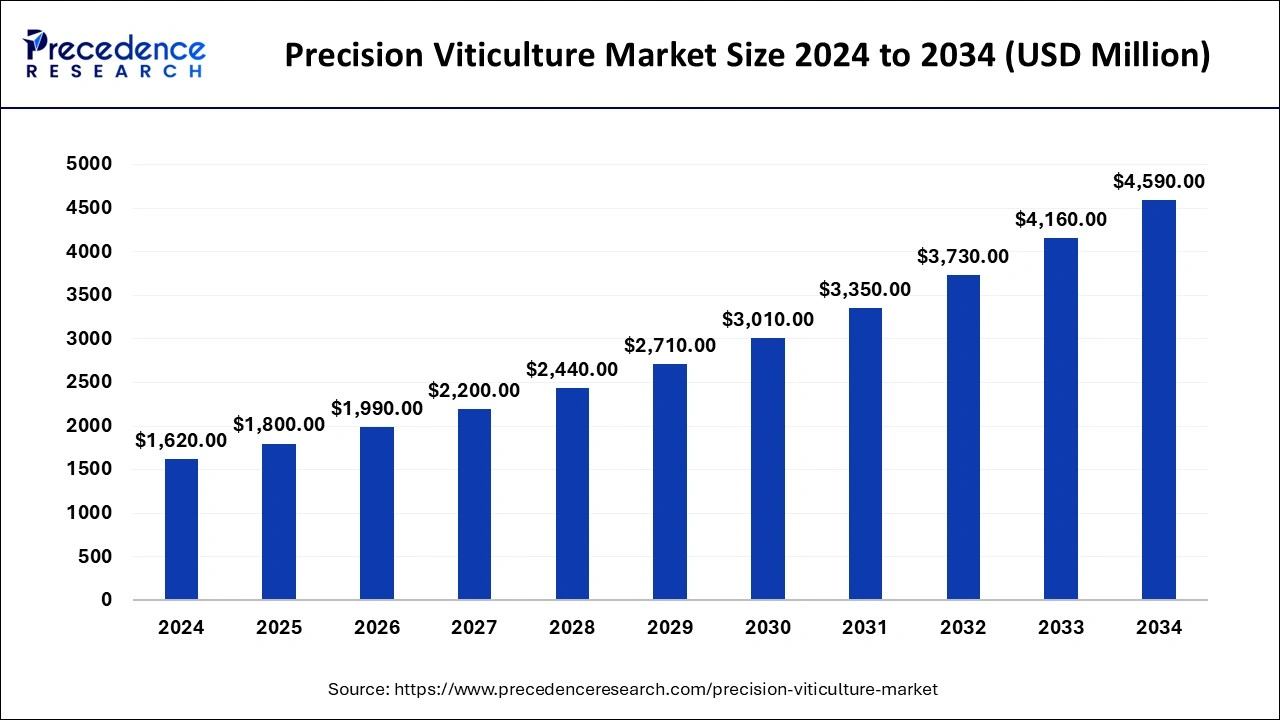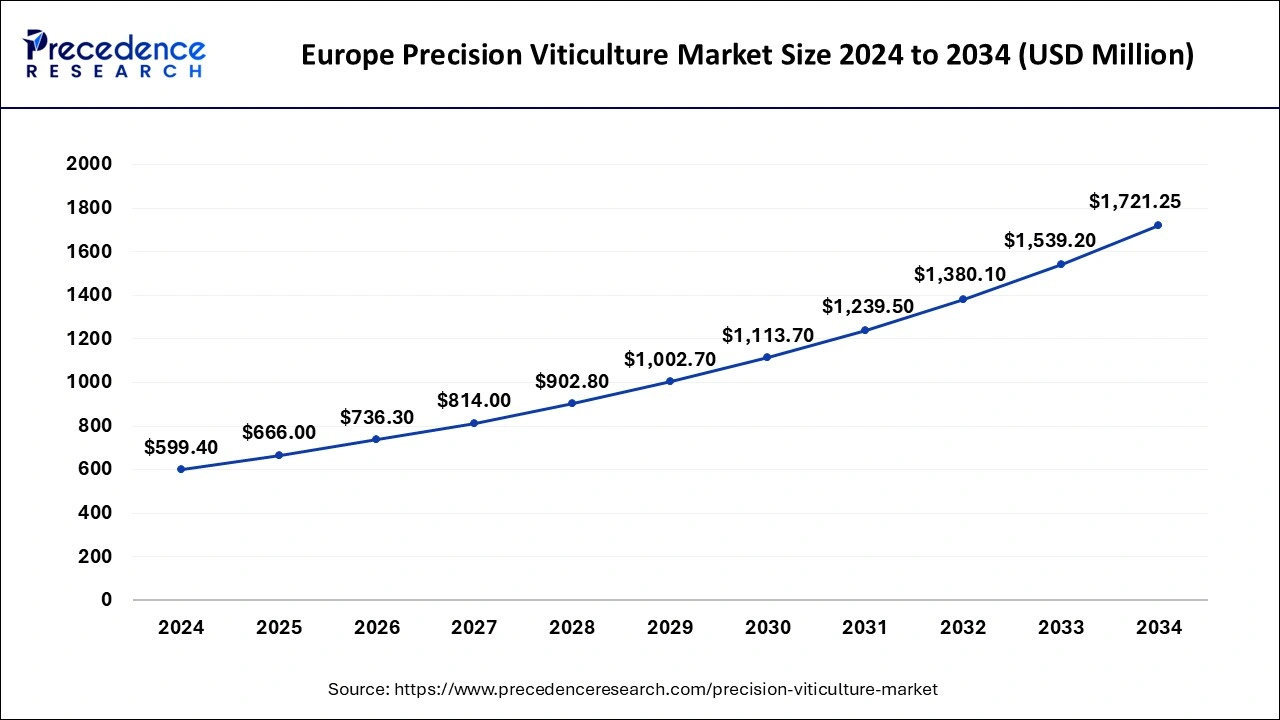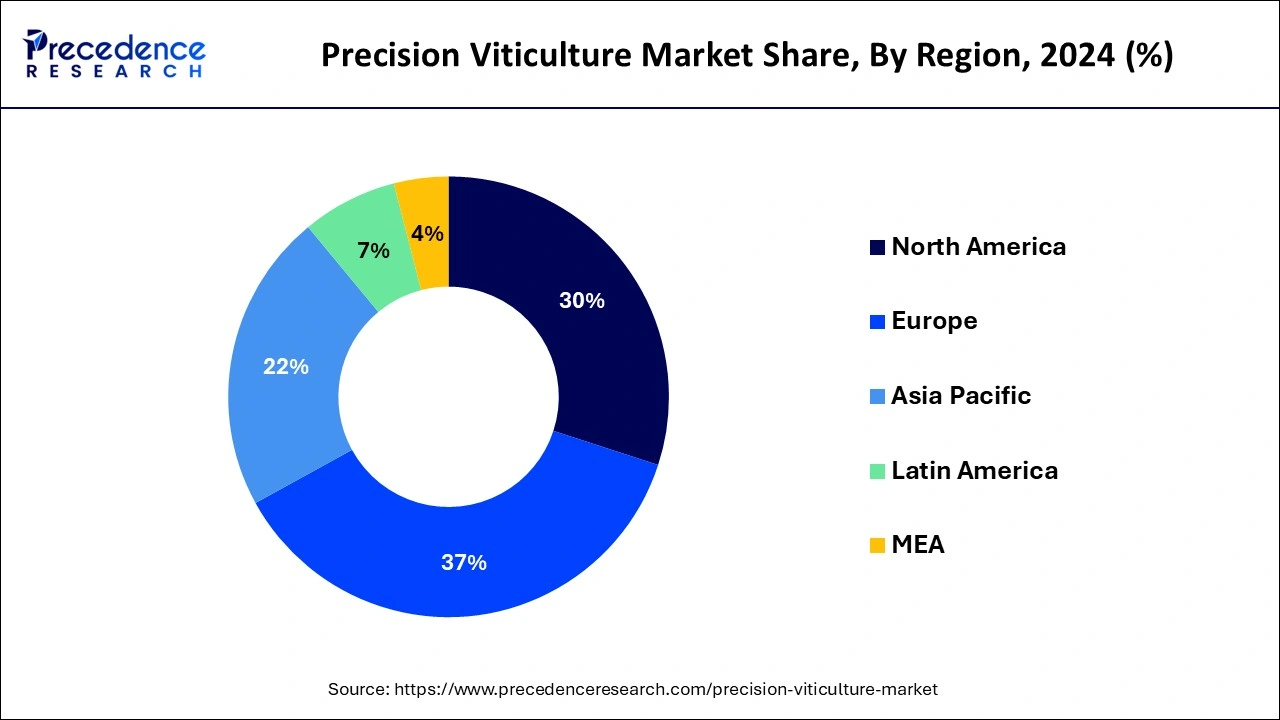December 2024
The global precision viticulture market size is evaluated at USD 1,800 million in 2025 and is forecasted to hit around USD 4,590 million by 2034, growing at a CAGR of 10.98% from 2025 to 2034. The Europe market size was accounted at USD 599.40 million in 2024 and is expanding at a CAGR of 11.13% during the forecast period. The market sizing and forecasts are revenue-based (USD Million/Billion), with 2024 as the base year.
The global precision viticulture market size was calculated at USD 1,620 million in 2024 and is predicted to increase from USD 1,800 million in 2025 to approximately USD 4,590 million by 2034, expanding at a CAGR of 10.98%.

The Europe precision viticulture market size was exhibited at USD 599.40 million in 2024 and is projected to be worth around USD 1,721.25 million by 2034, growing at a CAGR of 11.13% from 2025 to 2034.

In 2024, Europe held a share of 37% in the precision viticulture market due to its long-standing tradition of winemaking and a strong emphasis on quality. Vineyard owners in Europe are increasingly adopting precision farming technologies to optimize grape production, enhance wine quality, and address climate change challenges. Government support for sustainable agriculture and a well-established wine industry contributes to the region's market dominance. Additionally, a mature technological infrastructure and the awareness of precision viticulture's benefits position Europe as a significant player in the global market for advanced vineyard management.

Asia-Pacific is poised for rapid growth in the precision viticulture market due to increasing awareness of sustainable farming practices, rising demand for high-quality wine, and advancements in technology adoption. As vineyards in the region embrace precision techniques, such as sensor-based monitoring and data analytics, they enhance grape quality and optimize resource usage. Government initiatives supporting precision agriculture also contribute to the region's potential growth, making Asia-Pacific a key emerging market for precision viticulture technologies.
Meanwhile, North America is experiencing notable growth in the precision viticulture market due to a combination of factors. The region's established and technologically advanced agriculture sector is increasingly adopting precision farming practices. Rising awareness of resource efficiency, coupled with the demand for high-quality grapes and wine, is driving vineyards to invest in precision viticulture technologies. The integration of data analytics, IoT, and government support for sustainable agriculture further accelerates market growth, making North America a significant hub for the adoption and expansion of precision viticulture solutions.
Precision viticulture is an advanced approach to grape cultivation that utilizes technology to enhance efficiency and optimize grape production. By employing tools such as sensors, GPS, and data analytics, vineyard managers can collect detailed information about the variability in the vineyard, including soil conditions, weather patterns, and grape ripeness. This data-driven approach enables precise decision-making, allowing for targeted interventions like optimized irrigation, fertilization, and pest control.
Ultimately, precision viticulture helps vineyards maximize grape quality and yield while minimizing resource inputs, leading to more sustainable and economically viable grape farming practices. This method not only benefits grape growers but also contributes to the overall improvement of wine quality and the environmental sustainability of viticulture.
Precision Viticulture Market Data and Statistics
| Report Coverage | Details |
| Growth Rate from 2025 to 2034 | CAGR of 10.98% |
| Market Size in 2025 | USD 1,800 Million |
| Market Size by 2034 | USD 4,590 Million |
| Base Year | 2024 |
| Forecast Period | 2025 to 2034 |
| Segments Covered | Application and Component |
| Regions Covered | North America, Europe, Asia-Pacific, Latin America, and Middle East & Africa |
Driver
Environmental sustainability
Environmental sustainability is a key driver in surging market demand for precision viticulture. As consumers increasingly prioritize eco-friendly products, vineyard owners are turning to precision farming techniques to reduce their environmental footprint. Precision viticulture allows for targeted and efficient use of resources such as water, fertilizers, and pesticides, minimizing waste and negative impacts on the ecosystem. This aligns with the broader global movement toward sustainable agriculture, and vineyards adopting precision methods gain a competitive edge by showcasing their commitment to environmentally responsible practices.
Moreover, precision viticulture contributes to the preservation of biodiversity and soil health. By optimizing inputs and minimizing chemical usage, vineyards adopting precision techniques promote a healthier ecosystem. This resonates with environmentally conscious consumers who seek products that not only meet high-quality standards but also adhere to sustainable and ethical production practices. As the demand for sustainably produced wines grows, precision viticulture emerges as a pivotal solution, driving market expansion and influencing the future trajectory of the wine industry.
Variable economic returns
Variable economic returns pose a significant restraint on the market demand for precision viticulture. While the adoption of precision technologies offers long-term benefits such as increased efficiency and sustainable farming practices, the upfront investment required can be a barrier for many vineyard owners. Small and medium-sized vineyards, in particular, may hesitate to embrace precision viticulture due to concerns about the unpredictable nature of economic returns. The diverse factors influencing economic returns, including vineyard size, geographical location, and the scale of technology implementation, contribute to the hesitation among stakeholders.
Some vineyard owners may find it challenging to justify the initial costs if the benefits in terms of increased yield or improved grape quality are not immediately evident. Overcoming this restraint requires a clearer demonstration of the long-term economic advantages of precision viticulture, ensuring that vineyard operators can make informed decisions about technology adoption based on a more predictable and favorable economic outlook.
Customized solutions for different vineyard sizes
Customized solutions for different vineyard sizes are creating significant opportunities in the precision viticulture market. Recognizing the diverse scale of vineyard operations, precision viticulture providers can tailor their technologies to suit the specific needs and resources of vineyards, whether small, medium, or large. This approach ensures that even smaller vineyards with limited budgets can access and benefit from precision farming technologies, democratizing the adoption of these tools across the industry.
By offering scalable and cost-effective solutions, precision viticulture providers can tap into a broader market, expanding their customer base. Small and medium-sized vineyards, which may have been hesitant to invest in advanced technologies due to financial constraints, can now embrace precision viticulture to enhance efficiency, optimize resource use, and improve overall grape quality. This customization aligns with the goal of making precision viticulture accessible to a diverse range of vineyard operators, fostering growth, and contributing to the widespread adoption of these innovative farming practices.
The yield monitoring segment held the highest market share of 40% in 2024. In precision viticulture, the yield monitoring segment involves the use of technology to monitor and assess grape yield throughout the growing season. This application utilizes sensors and data analytics to provide real-time insights into the quantity of grapes produced by a vineyard. A key trend in yield monitoring is the integration of advanced sensors, satellite imagery, and machine learning algorithms, allowing vineyard managers to precisely estimate and optimize grape yields. This helps in making informed decisions related to harvest planning, resource allocation, and overall vineyard management, contributing to improved efficiency and productivity.
The weather tracking & forecasting segment is anticipated to witness rapid growth at a significant CAGR of 15.3% during the projected period. The weather tracking and forecasting segment in precision viticulture involves the use of technology to monitor and predict weather conditions impacting vineyards. This application helps vineyard managers make informed decisions regarding irrigation, disease prevention, and harvest timing. A notable trend in this segment is the integration of advanced weather sensors and data analytics, providing real-time weather information. This enables vineyard operators to proactively adjust their practices, optimizing grape cultivation in response to changing weather patterns and ensuring a more resilient and efficient viticulture process.
The hardware segment has held a 62% market share in 2024. In precision viticulture, the hardware segment encompasses the physical equipment and devices used to collect data and implement precision farming practices in vineyards. This includes sensors, GPS devices, drones, and other physical tools. Recent trends indicate a growing emphasis on the development of more advanced and cost-effective hardware solutions. Improved sensor technologies, increased integration of global positioning systems (GPS) for precise mapping, and the use of drones for aerial data collection are notable trends, aiming to enhance the accuracy and efficiency of data gathering in vineyard management.
The software segment is anticipated to witness rapid growth over the projected period. In the precision viticulture market, the software segment comprises applications and programs that facilitate data analysis, decision-making, and overall management of vineyard operations. Precision viticulture software allows users to interpret data from sensors, drones, and other sources, providing insights into factors like soil health, weather conditions, and grape ripeness. The trends in this segment include the integration of advanced analytics and machine learning for predictive modeling, enhancing the precision and effectiveness of viticultural practices, and the development of user-friendly interfaces to make these technologies more accessible to vineyard managers.
By Application
By Component
By Geography
For inquiries regarding discounts, bulk purchases, or customization requests, please contact us at sales@precedenceresearch.com
No cookie-cutter, only authentic analysis – take the 1st step to become a Precedence Research client
December 2024